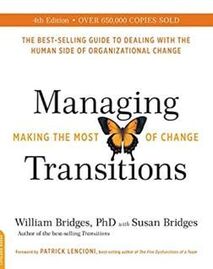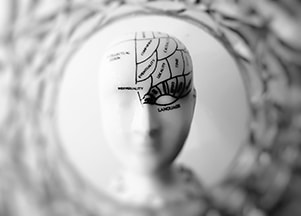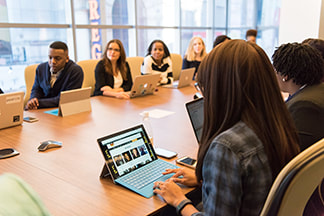 Change is easy. Navigating the many transitions of the change is not. Change is easy. Navigating the many transitions of the change is not.
10/23/2022, 12:45 p.m. CST
Read Time: 2 min. 30 sec. In the book Managing transitions: Making the most of change, written by William Bridges, leaders learn how change is easy, and transitions within the change are complex. The author describes that transitions are psychological and include a "three-phase process that people go through as they internalize and come to terms with the details of the new situation that the change brings about" (page 21 of 256). A transition consists of the ending (losing, letting go), the neutral zone, and the new beginning. In the ending, people have the challenge of letting go. Here, people must let go of things and behaviors that make up their identity. This is when leaders need to help their colleagues deal with their losses.
After the ending, we enter an uncertain time called the neutral zone. This is an odd place to find yourself. The old is not entirely gone, yet the new is unknown and chaotic, scary, and not fully operational. The neutral zone is an excellent time for creativity and innovation and a time for stress and anxiety. There is a lot of potential for growth in this stage. After surviving the stress of this transition, we enter a new beginning. In the new beginning, a new identity develops in people, new energy abounds, and people come to work with a new sense of purpose that makes the change work.
Patrick Lencioni reminds us that even positive change comes with loss and emphasizes the importance of a ceremony for the ending to move forward. It is about saying "goodbye" to the past while simultaneously burning your ship.
When discussing the neutral zone, Lencioni compares it to buyer's remorse. For example, you might be in a new job, wonder if you made the right decision, and debate about leaving it early on. Here, we remind ourselves of the loss and recognize that we control our response. As leaders, we must have astute situational awareness and deliver support to colleagues for their loss. If we do not offer support, people will return to the old way, give up, or quit and stay, leading to bitterness. We help others get through the neutral zone by showing up, being present, telling the truth, and letting go of the outcomes. And we do this through care and concern. This is when we try to reassure that it will be okay and the challenge is not attempting to solve the problem for someone else. Some examples to help teachers who are in the neutral zone are: include providing time and training, providing factual information, offering teachers roles to participate in, and offering time for teachers to discuss and reflect with leaders. 
Change is easy. Navigating the many transitions of the change is not. People must be constantly reminded of four programmatic and specific things when going through a change: purpose, picture, plan, and part. It is essential to continually remind people why (purpose) they are going through the change in the first place. Second, painting a picture of the destination of where we are going and why it will be better. Third, have a plan delivered in small, understandable, and doable chunks for the change, and, finally, people will need to know their part, or role, in the transition. Change is external and usually welcomed once it is over. The multiple internal transitions within the change often make it hard. As leaders, it is our responsibility to help everyone through the change. This means supporting people through the multiple internal transitions that often make change hard. We must be there for our colleagues, answer their questions, and help them understand what is happening. Only by working together can we successfully navigate through times of change and come out stronger on the other side.
References:
0 Comments
10/9/2022, 11:35 a.m. CST Read Time: 2 min. 33 sec. Last week we were introduced to the ladder of inference. The ladder of inference is a mental model that helps us understand how we come to the conclusions we make. It starts with the data we take in from our senses (what we see, hear, etc.). From there, we add our own interpretation to the data. Finally, we come to a conclusion and take action based on that conclusion. When used correctly, the ladder can save you from the proverbial foot-in-the-mouth. This is done by thinking more with facts and not automatically jumping to conclusions. Ultimately, the ladder can help you explain your thinking and reasoning to others. Thinking and explaining your thinking to someone isn't always the easiest. Sometimes we clam up, get defensive, or avoid the situation altogether, which drowns any potential for collaboration—knowing how and when to collegially say what you're thinking is done through a balance of advocacy (stating our views) and inquiry (asking questions). We must know when it is the right time to state our views and ask questions; context is critical. Pushing out emergency information would not be a time for inquiry. However, having a planning meeting and leaving with a plan for communicating emergency information would include a healthy combination of advocacy and inquiry. Below are a few protocols and prompts written by Senge et al. (2012) that help facilitate advocacy and inquiry with some pointers on what to say when you get stuck in a situation (pp. 104-107). To help with advocacy (stating your views):
To help with inquiry (asking questions to reveal thinking in others):
When you are stuck in a disagreement:
When you are at an impasse:
In any situation, we must be aware of our biases and assumptions. We all tend to jump to conclusions, which can lead to conflict and misunderstanding. Recall the ladder of inference is a model to help us slow down our jumping to conclusions. The best way to avoid conflict and misunderstanding while building diverse perspectives is to practice a balance of advocacy and inquiry. Inquiry involves asking questions and genuinely listening to the answers. Advocacy is about sharing our views in a way that invites dialogue and debate. Combining these two approaches creates an environment where different perspectives can be heard and respected. This, in turn, leads to greater collaboration and understanding. So, the next time you find yourself in a disagreement, remember the importance of advocacy and inquiry. It may just be the key to finding common ground. See this short article from the Systems Thinker to learn more about how to have productive conversations. References:
10/2/2022, 12:50 CST Read Time: 2 min. 31 sec. Can 1+1=3? Have you experienced a situation with multiple people, yet everyone remembers it differently? Even better, someone looked at you wrong, not realizing they were making a face at the person behind you? As Kramer and Newman unpack the events of June 14th, 1987, Keith Hernandez remembered it differently. As a teacher, you are constantly making decisions based on the information you have. Sometimes, these decisions are small, like what to do when a student breaks a rule. Other times, they are much larger, like whether or not to recommend a student for expulsion. Regardless of the size of the decision, you always want to be sure that you are basing your decisions on accurate information. The ladder of inference is a cognitive model that helps us understand how we come to the conclusions we make. It starts with the data we take in from our senses (what we see, hear, etc.). From there, we add our own interpretation to the data. We might make assumptions based on our experiences or form judgments about what we think is right or wrong. All of this happens very quickly and often without us even realizing it! Finally, we come to a conclusion and take action based on that conclusion.The ladder comprises six "rungs" and sits on top of observable data and experiences. Starting from the top rung to the bottom rung:
As quirky as Kramer can be, he had a sense of inquiry and asked Hernandez "who did it" since he denied doing it. When doing this, Kramer came down the ladder. At this point, Kramer, Newman, and Hernandez recall the event. Still, while talking, Kramer and Newman quickly realize that Hernandez saw what happened differently. And come to find out, it was Roger McDowell (this is how 1+1=3)! In the end, Roger was talking and pointing right at Kramer and Newman (I'm guessing telling someone what happened to him during the game, my assumption rung of the ladder!). At the same time, Keith yells at Kramer to get out of the way, but it is too late! And to come down even more on the ladder, Jerry asks Keith, "why?" and then the real answer comes out. Kramer admits how he and Newman were picking on McDowell in the bullpen during the game. Did Kramer deserve what happened? Probably. Did he have the wrong guy? Absolutely. Based on their interpretation of an event, did Kramer and Newman hold onto misdirected anger towards Hernandez for far too long? You bet. The ladder of inference is a cognitive model that helps us understand how we come to the conclusions we make. It starts with the data we take in from our senses (what we see, hear, etc.). From there, we add our own interpretation to the data... Finally, we come to a conclusion and take action based on that conclusion. As teachers, we must be aware of this process and take steps to ensure that we base our decisions on accurate information. Watch the video below to learn more about the ladder of inference, and here is an article that helps explain this in more detail. References:
 How do you and your team "focus?" How do you and your team "focus?" A Google search for focus revealed “about” 4,570,000,000 results. With so many results it is no wonder why so many individuals and organizations are seeking ways to improve their focus on something. Perhaps it is productivity, concentration, attendance, grades...the list seems endless. When leading a classroom, building, or district, focus has to be top of mind, literally. But what exactly is focus? On any given day our team works cross functionally with nine buildings, hundreds of personnel, and support thousands of devices across the network. Focus is crucial to our success. Our team recently completed reading Boundaries for Leaders (Cloud, 2013), and found that the big secret to increasing individual and team focus consists of three components:
 How do you keep your focus? How do you keep your focus? WHAT WE LEARNED We learned that we have to pay attention to what matters most by focusing on the relevant (attending), block distractions by not letting them in (inhibiting), and increase our individual and collective memory by having systems in place to help us to "remember and build on relevant information" (working memory). And that is when it hit me. While we learned the importance of having a system in place to help us focus, we had a little work to do with our newly found knowledge. Here is how we use the executive functions of the brain to help our individual and collective focus. The executive functions of the brain (attending, inhibiting, working memory) are now common language and practice in our system, and here are a few examples.  Make your meetings matter with the recommendations from Lencioni. Make your meetings matter with the recommendations from Lencioni. We attend by:
We inhibit by:
And finally, we increase our working memory by:
NUGGETS OF KNOWLEDGE
The resources included in Cloud’s writing, most notably the meeting processes of Lencioni, have completely reshaped how we approach meetings and work with one another. Focusing by using the executive functions keeps us on task while avoiding getting lost in what McChesney, Covey, & Huling (2012) refer to as the whirlwind. The knowledge and examples in Boundaries for Leaders fundamentally changed the way we do business. Is that not something you would like for your department or building? The goal is to attend to what matters, block out as many distractions as possible, and find a way to keep what matters most in front of you and your team as often as possible. Remember, "you get what you create or allow and you are ridiculously in charge!" (Cloud, 2013). I found these resources for improving our focus to be of great use and hope you do as well. Let me know how, or what processes you use to increase your individual and team’s focus in the comments below.
|
 RSS Feed
RSS Feed